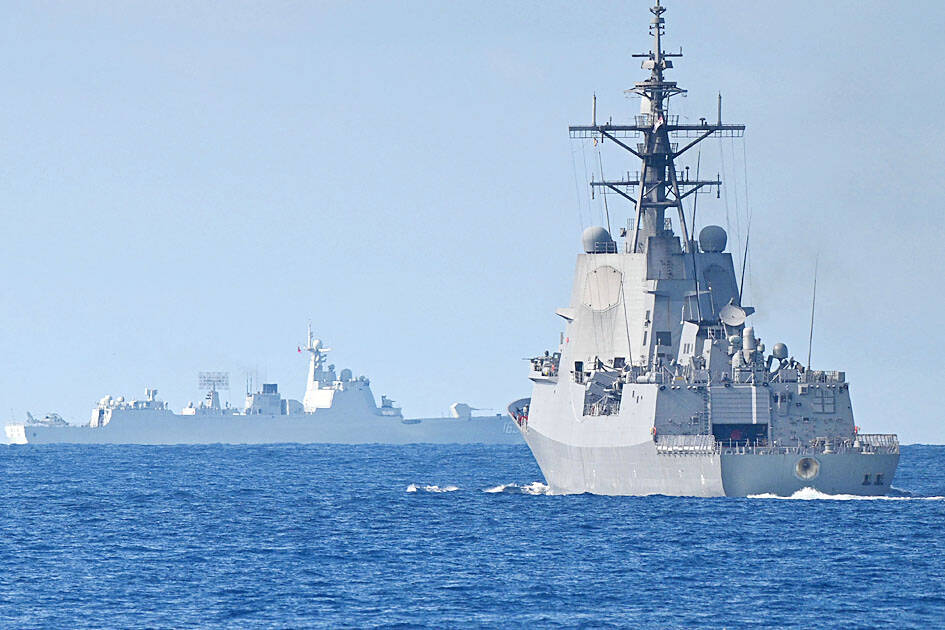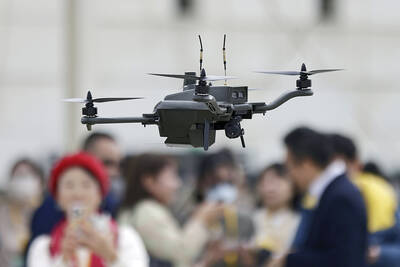Canadian frigate the Ville de Quebec and Australian guided-missile destroyer the Brisbane transited the Taiwan Strait yesterday morning, the first time the two nations have conducted a joint freedom of navigation operation.
The Canadian and Australian militaries did not immediately respond to requests for comment.
The Ministry of National Defense declined to confirm the passage, saying only that Taiwan’s armed forces had deployed surveillance and reconnaissance assets, along with warships and combat aircraft, to safeguard security across the Strait.

Photo: AFP
The two vessels were observed transiting northward along the eastern side of the Taiwan Strait’s median line, with Japan being their most likely destination, a naval expert said on condition of anonymity.
The Ville de Quebec is equipped with advanced anti-submarine and air defense systems, while the Brisbane features the US-designed Aegis Combat System, which incorporates state-of-the-art Active Electronically Scanned Array radar technology, they said.
The Australian destroyer’s participation signaled Washington’s readiness to see Indo-Pacific region partners assume a greater role in regional security, as freedom of navigation operations in the Taiwan Strait have until now been carried out primarily by the US and Canada, they added.
Canadian media reported that the Ville de Quebec recently took part in another freedom of navigation operation alongside Philippine, Australian and US warships, with the three nations’ navies later conducting drills near the Scarborough Shoal (Huangyan Island, 黃岩島).
The Canadian Department of National Defense said in a statement that the exercise was conducted in line with international maritime law and with due regard for navigational safety.
The operation drew a sharp response from Beijing. A spokesperson for the Chinese People’s Liberation Army’s (PLA) Southern Theater Command said the Philippines was “soliciting foreign countries to conduct so-called joint patrols” and “undermining regional peace and stability,” the Australian reported.
Meanwhile, China’s state-run Global Times newspaper confirmed in a report yesterday that two warships from Canada and Australia transited the Taiwan Strait.
“The PLA maintained full surveillance and monitoring throughout the transit, with the situation fully under control,” the paper said.
Chen Shih-min (陳世民), an associate professor of political science at National Taiwan University, said the joint Canadian-Australian operation could be interpreted as a pointed response to Beijing’s military parade on Wednesday, which Chinese President Xi Jinping (習近平) attended alongside Russian President Vladimir Putin and North Korean leader Kim Jong-un.
The transit sends a message that China’s alignment with Russia, North Korea and Iran would not deter the West from defending freedom of navigation, Chen said.
Despite uncertainties surrounding US President Donald Trump, Western democracies remain broadly united, with other democratic nations increasingly eager to align with them to safeguard their security, he said.
These developments are positive for Taiwan, he added.
Transits of foreign warships through the Taiwan Strait have become an increasingly common and accepted practice, often taking place as part of naval exercises, Institute for National Defense and Security Research analyst Shu Hsiao-huang (舒孝煌) said.
Given that Canadian and Australian vessels had already been conducting drills together in regional waters and were likely bound for Japan, the decision to sail through the Strait was a logical extension of their operations, he said.
The coordinated passage also indicates that the two nations had developed an understanding on the transit, pointing to a deeper level of military cooperation between their armed forces, Shu added.
Additional reporting by Reuters

The combined effect of the monsoon, the outer rim of Typhoon Fengshen and a low-pressure system is expected to bring significant rainfall this week to various parts of the nation, the Central Weather Administration (CWA) said. The heaviest rain is expected to occur today and tomorrow, with torrential rain expected in Keelung’s north coast, Yilan and the mountainous regions of Taipei and New Taipei City, the CWA said. Rivers could rise rapidly, and residents should stay away from riverbanks and avoid going to the mountains or engaging in water activities, it said. Scattered showers are expected today in central and

COOPERATION: Taiwan is aligning closely with US strategic objectives on various matters, including China’s rare earths restrictions, the Ministry of Foreign Affairs said Taiwan could deal with China’s tightened export controls on rare earth metals by turning to “urban mining,” a researcher said yesterday. Rare earth metals, which are used in semiconductors and other electronic components, could be recovered from industrial or electronic waste to reduce reliance on imports, National Cheng Kung University Department of Resources Engineering professor Lee Cheng-han (李政翰) said. Despite their name, rare earth elements are not actually rare — their abundance in the Earth’s crust is relatively high, but they are dispersed, making extraction and refining energy-intensive and environmentally damaging, he said, adding that many countries have opted to

SUPPLY CHAIN: Taiwan’s advantages in the drone industry include rapid production capacity that is independent of Chinese-made parts, the economic ministry said The Executive Yuan yesterday approved plans to invest NT$44.2 billion (US$1.44 billion) into domestic production of uncrewed aerial vehicles over the next six years, bringing Taiwan’s output value to more than NT$40 billion by 2030 and making the nation Asia’s democratic hub for the drone supply chain. The proposed budget has NT$33.8 billion in new allocations and NT$10.43 billion in existing funds, the Ministry of Economic Affairs said. Under the new development program, the public sector would purchase nearly 100,000 drones, of which 50,898 would be for civil and government use, while 48,750 would be for national defense, it said. The Ministry of

UNITED: The other candidates congratulated Cheng on her win, saying they hoped the new chair could bring the party to victory in the elections next year and in 2028 Former Chinese Nationalist Party (KMT) lawmaker Cheng Li-wun (鄭麗文) yesterday won the party’s chair election with 65,122 votes, or 50.15 percent of the votes. It was the first time Cheng, 55, ran for the top KMT post, and she is the second woman to hold the post of chair, following Hung Hsiu-chu (洪秀柱), who served from 2016 to 2017. Cheng is to succeed incumbent Eric Chu (朱立倫) on Nov. 1 for a four-year term. Cheng said she has spoken with the other five candidates and pledged to maintain party unity, adding that the party would aim to win the elections next year and